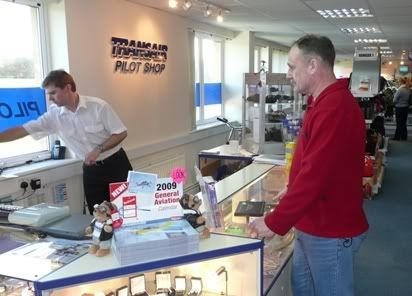The weather was forecast to deteriorate during Saturday, but I figured I might get lucky in the morning. For once I did. There was blue sky with very scattered cumulus at 2500' and light winds at about 200/10.
I promised my neighbour a ride, so we set out for the airfield. He is keen to learn to fly on his return to Canada in the summer and already has a couple of lessons booked in the UK to get him started. I bought him the excellent 'Stick and Rudder' book for him to read first. He was interested in seeing a stall, so I figured I might as well do a local with some general handling refreshers for me, as I only had the plane booked until midday.
So I checked tghe plane out and got it ouit of the hangar. Low on fuel (as usual), so off the the pumps first. I took care while taxiing to keep the stick in the correct position and parked into wind at the pumps, although not a howling wind, it was good practice to carry out the correct taxi techniques.
I topped her up to about 3 hours worth of fuel then set off. We were given E1 for 22. Power checks were good and I lined up after a departing Cessna 172 and started the take off run. Stick slightly forward of neutral and feed in right rudder. Tail coming up, bit more right rudder. Hold her down while speed build, then relax back pressure and up she jumps. I am 'catching' the Cessna ahead, but I continue a right turning climb through the circuit height as we head to the north.
Mark wanted to see stalls in action, so we climb to about 4000' between the Malverns and Bredon Hill. First I start with a few normal turns and steep turns and explain to Mark the primary and secondary effect of controls and co-ordinated use of the rudder. The RV really only needs a dab or rudder to get it into and out of the turn, once in, it seems quite happy on ailerons alone (as with most modern, well co-ordinated aircraft).
We move onto stalls. I carry out and explain the HASELL check and do three clean stalls. Power off, carb heat on and maintain altitude by gradually pulling back and back on the stick. The stall warner starts to blare, then at just under 60kts indicated, the stall starts. I allow it to properly develop. The RV has a more pronounced stall that normal training aircraft, that said, it is not scary or viol;ent, just a little bit more obvious than in say, a Cessna or a PA28. It give plenty of warning, but when it does stall, there is a noticeable drop of the nose and it always dropped the lefty wing. I hold the left wing with right rudder, power to full and stick slightly forward of neutral (with the powerful elevators on the RV, if I pushed the stick fully forward we would probably be in a near vertical dive - overdoing it a tad I suspect!)
On one occasion, we took 150' to recover, on the other two, only 100'. I think the stalls got Maqrk's attention and hopefully put into context what he had read in 'Stick and Rudder'.
We did some climbs and descents, then I decided to practice a forced landing. Power off, carb heat on. Trade speed for altitude to get to best glide. Decinde where the wind is coming from and find a field. Although I was near a disused airfield, it was out of range, so I selected a large field, but it was very close and I was way too high. So I orbited the field to lose height and tried to time mu turn into final.
Again, I was way high, so flaps on and some heavy sideslip. I got the picture back and was sure I would have made the field when I spotted someone walking their dog in the otherwise deserted field. I wasn't too far away when I put the power back on for the go around and I hope I didn't scare him too much!
I explained to Mark how sideslipping worked and that it was one of the two main methods used for a crosswind landing, but that crabbing and kicking off with the rudder in the flare seemed to be the one most widely taught at the moment.
All too soon, we had been in the air for one hour and were approaching 11:30. The plane was booked by another group member for 12:00, so I headed back to the field so I could get down and switched off in plenty of time.
I grabbed the ATIS and asked for a direct join. I was told to report at 5 miles as we headed back. I set the plane up for airfield approach and did the 'downwind' checks (it is precisely on direct approaches that people forget to do the 'downwind' checks, because of course there is no 'downwind').
I am in luck, the circuit is not crowded and we get a direct to final join behind a Firefly. I can't see him until some directions from ATC, then Mark spots him. We are far enough back as I slow down and deploy flaps.
I get the wind as 200 / 12 and I am comning in on 22 - this accords with the airsock and I briefly explain how I calculate the crosswind component to Mark. Basically 20 degree off runway heading, with 30 degrees you take half the wind, so in this case guess at a 5 kt crosswind component. Nothing to worry about, but be aware of it and ready to counter with left aileron and right rudder if required.
Nicely established on final as the Firefly touches. I hear ATC asking the Firefly to keep speed up and vacate next left. I am quite confident that he will vacate before I am over the hedge, so I expect a late clearance. The tower instead gives me a 'land after' which I am very happy to accept. Sure enough, the Firefly is off as I come over the hedge anyway.
Start the roundout, power off and flare and hold off, and off and off. Stall warner blaring, off more yet and we touch and stay touched. No noticeable crosswind component as I continue to ease the stick back to the full rearward limit of travel (back in the b*ll*cks as my first instructor so graphically described it) to nail the tailwheel on the gound as we taxi to the exit.
We get her back to the stand as a Citation jet calls for taxi just outside my hangar. I cautiously hold well clear of his jet blast as it would ruin my day if her blew us over. Once he is well clear, we venture forward and shutdown and hangar up.
A nice flight with some skills practice. Not what I really wanted to do, but valuable and fun nevertheless. I'll just put my East Anglia trip on ice for another time, maybe in February when I have a free landing voucher for Tibenham?
Mark has his first couple of lessons booked so I suggest we trot over to Transair to buy him a logbook.

An important moment in learning to fly, that first logbook. And yes Mark, here is that photograph, sorry!
I think my flying plans for 2009 are starting to shape up now. I have tentatively pencilled in the second week in October for a one week trip to visit my brother-in-law's brother who live in Texas and is a retired USAF Colonel and an FAA instructor. I plan on hiring a plane there and doing maybe a three / four day flying tour around interesting places in Texas, hopefully with Canada Dan if he can get the time off. I also plan a couple of weekends in France and maybe a bank holiday weekend to Copenhagen if nthe weather plays ball.
Meanwhile, I am now the Treasurer for the G-GDRV group and am in the process of taking over cheque books and bank statementsb etc. It isn't too tough and I have done it before. I guess it was about time I contributed something to the group.
